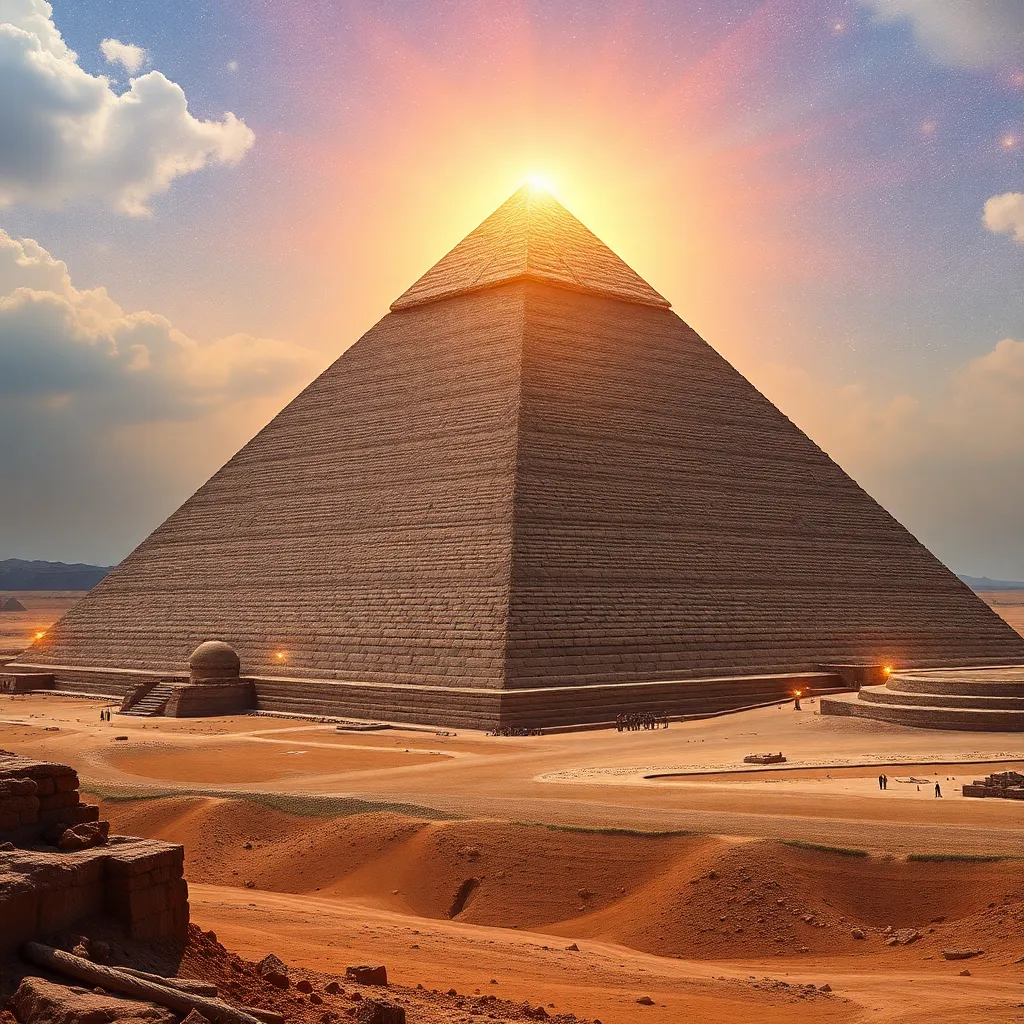The Cosmic Significance of the Great Pyramid of Giza
I. Introduction
The Great Pyramid of Giza, one of the most remarkable architectural feats of ancient Egypt, stands as a testament to the ingenuity and ambition of its builders. This monumental structure, built during the reign of Pharaoh Khufu, is not only a tomb but also a symbol steeped in cosmic significance. Ancient civilizations often ascribed great importance to celestial phenomena, integrating their understanding of the cosmos into their cultural practices and belief systems.
This article aims to explore the astronomical, spiritual, and cultural implications of the Great Pyramid of Giza, shedding light on its role in the ancient Egyptian worldview and its lasting legacy in the context of human connection to the universe.
II. Historical Context of the Great Pyramid
The construction of the Great Pyramid dates back to around 2580–2560 BCE, making it one of the oldest and largest pyramids in the world. Built as a tomb for Pharaoh Khufu, the pyramid originally stood at 146.6 meters (481 feet) tall, showcasing the architectural prowess of the ancient Egyptians.
The construction methods employed were revolutionary for their time, involving vast labor forces and advanced engineering techniques. The use of ramps to move massive limestone blocks and the precise alignment of the structure demonstrate a sophisticated understanding of mathematics and geometry.
In ancient Egyptian beliefs, the afterlife was a significant aspect of existence. The Great Pyramid was designed not just as a final resting place for Khufu but as a gateway to the stars, facilitating the pharaoh’s journey into the afterlife and his union with the divine cosmic order.
III. Astronomical Alignments and Measurements
The Great Pyramid is renowned for its precise orientation to the cardinal points of the compass. Its sides are closely aligned with true north, south, east, and west, showcasing the ancient Egyptians’ profound knowledge of astronomy.
Furthermore, the pyramid’s construction correlates with notable celestial bodies:
- Orion’s Belt: The three main pyramids of Giza are thought to represent the three stars of Orion’s Belt, indicating a connection to the god Osiris.
- Sirius: The rising of the star Sirius marked the flooding of the Nile, a critical event for agriculture and the Egyptian calendar.
The dimensions of the Great Pyramid further resonate with the Earth’s measurements, as its base perimeter is nearly equal to the Earth’s circumference, suggesting an intentional design that reflects the relationship between terrestrial and cosmic realms.
IV. Symbolism and Spirituality
The Great Pyramid serves as a powerful symbol of the sun’s rays, representing the pharaoh’s ascent to the heavens. In Egyptian mythology, the pyramid’s shape is akin to a beacon of light, guiding souls toward the afterlife.
Moreover, the pyramid connects deeply with various cosmic deities:
- Ra: The sun god, embodying light and creation.
- Osiris: The god of the afterlife, symbolizing regeneration and rebirth.
In this spiritual framework, the Great Pyramid plays a critical role in the journey of the soul after death, serving as a conduit for the deceased to navigate the afterlife and attain immortality.
V. The Pyramid’s Influence on Ancient Astronomy
The Great Pyramid not only served as a tomb but also functioned as an observatory, facilitating early astronomical observations. The ancient Egyptians utilized the pyramid’s height and positioning to track celestial events, significantly contributing to their understanding of the cosmos.
Some key contributions include:
- Development of a calendar system based on lunar cycles and solar events.
- Advancements in measuring time and predicting seasonal changes.
The knowledge gleaned from the Great Pyramid influenced later civilizations, shaping their astronomical practices and enhancing their comprehension of the universe.
VI. Modern Interpretations and Theories
Contemporary research continues to unveil the mysteries surrounding the Great Pyramid. New technologies, such as infrared scanning and 3D modeling, have revealed hidden chambers and complex structures within the pyramid.
Alternative theories regarding its cosmic significance abound, including ideas about the pyramid as a power generator or as a tool for spiritual enlightenment. The Great Pyramid’s representation in popular culture—through films, literature, and art—further cements its status as a symbol of humanity’s quest for knowledge and understanding of the cosmos.
VII. The Great Pyramid in the Context of Global Monuments
When compared to other ancient structures, such as Stonehenge in England or Chichen Itza in Mexico, the Great Pyramid shares common cosmic themes. Each of these sites reflects the civilizations’ attempts to connect with celestial phenomena and understand their place within the universe.
Some shared cosmic themes among ancient cultures include:
- Alignments with solar and lunar events.
- Construction based on astronomical knowledge.
- Symbolism related to deities of the cosmos.
The Great Pyramid stands as a universal symbol of human connection to the universe, emphasizing the shared aspirations of ancient civilizations to explore and understand the cosmos.
VIII. Conclusion
In conclusion, the Great Pyramid of Giza exemplifies the cosmic significance that ancient Egyptians attached to the cosmos. Its alignment with celestial bodies, rich symbolism, and historical context reveal a civilization deeply engaged with the mysteries of the universe.
The enduring mysteries surrounding the Great Pyramid inspire us to reflect on the lessons from ancient civilizations and their profound connections to the cosmos. Preserving and studying these remarkable monuments is essential for future generations, as they offer insights into humanity’s quest for understanding and meaning in an ever-expanding universe.




